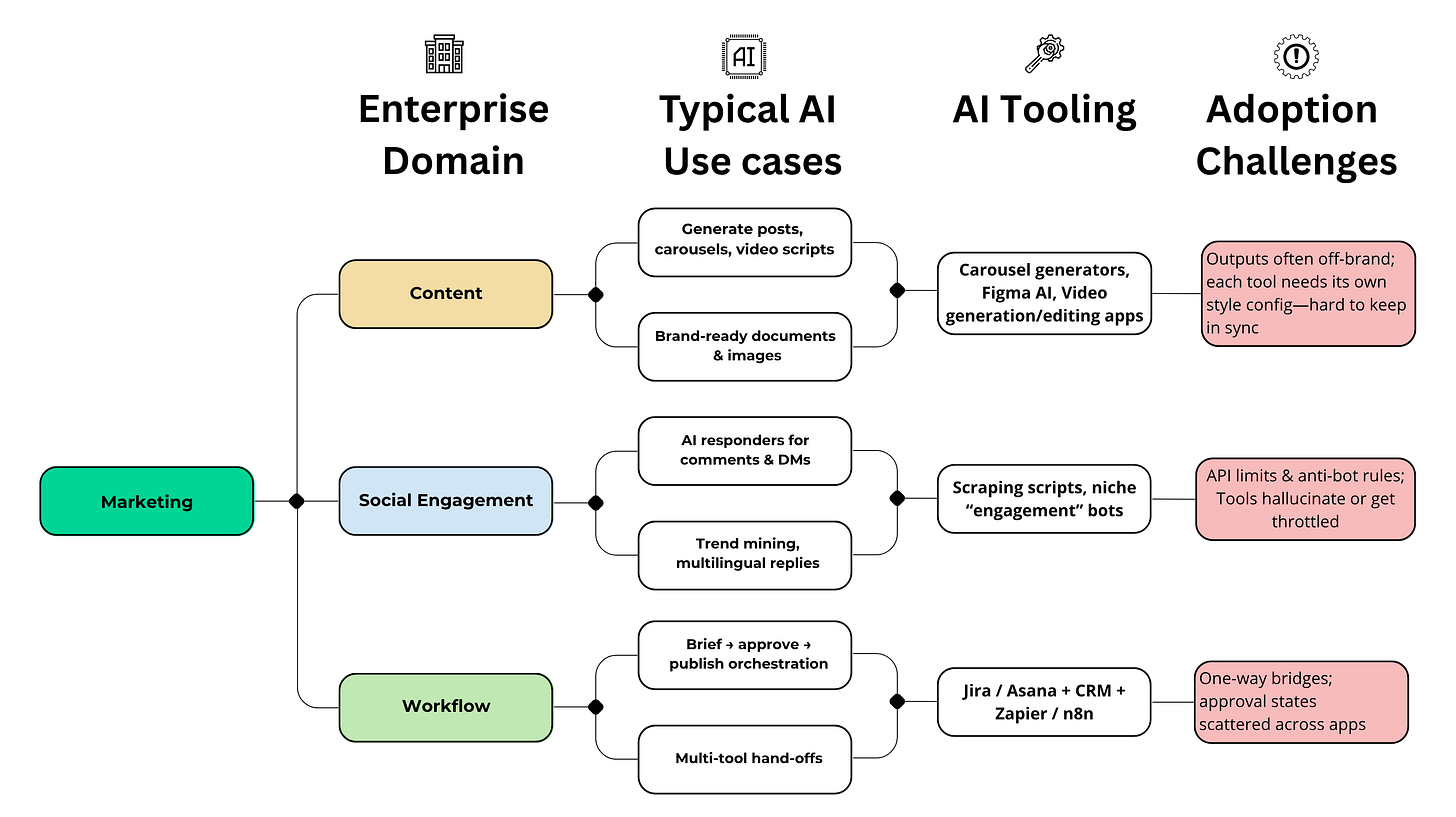The Hidden Cost of Scattered AI Tooling
And a Four-Layer Framework for Scalable Enterprise Adoption
Executive Summary
Enterprises that ignore AI-driven automation leave money on the table and accumulate operational debt. Yet the rush toward “AI everywhere” often swaps one kind of debt for another. A torrent of shiny point solutions - each promising faster insight or bolder creativity - creates one more login, one more workflow gap, and one more risk of brand or compliance drift.
When interviewing six VP and C-suite leaders in finance and marketing, several recurring headaches came to light.
The rest of this article lays out a four-layer framework for moving from disconnected experiments to scalable, agent-driven orchestration - plus a rollout roadmap, metrics, and risk guards.
What Enterprises Actually Do with AI Today
Engineering and Support are two areas that have a slew of tooling that is actually reasonably well integrated. For this reason, these two domains have been excluded from the study, and I’ve chosen to focus on two particular tricky areas - each with contrasting challenges.
1. Finance
Finance is particularly challenging for multiple reasons:
LLMs are until date weak at dealing with large financial datasets, and making sense of them
AI generated analyses are shallow and lack special insight
LLM math capabilities are sub par, and financial data retrieval is abysmal
LLMs outputs are non-deterministic or weakly deterministic, while finance demands high precision
Finance products today just don’t yield much value addition from AI features, over and above improved data mining via natural language queries.
2. Marketing
Marketing has a problem of plenty. With hundreds of point solutions available for various pieces of marketing operations, there’s a glaring absence of a common thread that connects the dots between them.
Recurring Pain Points
The challenges of the pre AI era - tool fragmentation, siloed data and knowledge, and brittle infrastructure - are only exacerbated by the rapid adoption of AI across organizations. As these systems grow, small instances of operational and technical debt quietly accumulate, eventually compounding into a significant cost burden. Left unchecked, this often leads to large-scale re-architecture efforts to restore cohesion and efficiency.
A Four‑Layer Framework for Sustainable AI Adoption
Instead of chasing every new app or model, enterprises need a structured, scalable approach to integrating AI into the flow of work. The following sections introduce a Four-Layer Framework designed to anchor your AI investments in long-term value.
Enterprise AI adoption is most effective with cross-department orchestration
Implementation Roadmap
The key is to ground the vision in execution and layering in automation where it counts. Below is a practical rollout sequence that helps organizations move from scattered tools to cohesive, agent-driven workflows.
Inventory & Map - Audit all scripts, connectors, and AI endpoints.
Consolidate - Retire duplicated flows (e.g., multiple carousel generators); align teams on platform choices.
Establish the Knowledge Registry - Host brand assets, content patterns, and product data in one machine-readable location.
Pilot the Orchestrator - Use n8n or Zapier to trial a true end-to-end content pipeline, from idea ➝ publish.
Deploy Agentic Bots - Start with repetitive tasks: social monitoring, draft emails, report first passes.
Measure & Iterate - Track time saved, human touchpoints avoided, brand compliance rates, and quality of AI outputs.
6 · Success Metrics & KPIs
To tell whether your orchestration-first AI strategy is actually moving the needle, track a small set of operational KPIs that bridge automation depth, quality, and consolidation. The table below lists five metrics our interviewees say matter most - each tied to either efficiency (hours saved, steps removed) or robustness (brand compliance, tool rationalization).
Risks & Mitigations
1. "It works, but no one uses it"
Root cause: Tools built without UX testing, observed by multiple interviewees
Mitigation: Assign product owners to AI workflows, not just engineers
2. Locked into inflexible platforms
Root cause: Tools don't export knowledge or connect well
Mitigation: Choose API-first, standards-compliant tools
3. Change fatigue
Root cause: Too many overlapping pilots or unclear ROI
Mitigation: Focus on high-pain workflows and measure results early
4. Data-quality drift
Root cause: Data-schema changes and new scenarios introduce unmapped edge-cases
Mitigation: Periodic schema audits, automated validation rules, flag low-confidence outputs for review
The Path Forward
We’re undeniably in a period of rapid change, with AI tooling evolving each week. This rapid pace inevitably introduces friction and instability into enterprise adoption cycles. For the foreseeable future, enterprise AI will continue to be a tool grab - stacking point solutions for each task.
But the shift to a more organized structure is slowly taking shape in parallel: from individual bots and generators to orchestration, integration, and agentic work. Teams are beginning to ask not just “what can this tool do?” but “how does this tool plug into our broader system of work?”
Success hinges on three enablers:
A shared knowledge base, brand and data registry
A robust orchestration layer
And a growing ecosystem of connected agentic tools that can act, reason, and escalate.
The result will be eventually - Fewer logins, fewer hand-offs, fewer hours wasted fixing AI’s “helpful” mistakes - and more time spent on judgment, insight, and creative differentiation.








Gartner predicts that 40% of Agentic AI projects will be canceled by the end of 2027. This is a symptom of a rapidly growing early-stage market, and the rush to keep up. I however believe that AI adoption will only continue to accelerate, albeit with several corrections and consolidations along the way.
https://www.gartner.com/en/newsroom/press-releases/2025-06-25-gartner-predicts-over-40-percent-of-agentic-ai-projects-will-be-canceled-by-end-of-2027